Seat Ibiza 5D 2006 Owner's manual
Manufacturer: SEAT, Model Year: 2006, Model line: Ibiza 5D, Model: Seat Ibiza 5D 2006Pages: 268, PDF Size: 8.14 MB
Page 221 of 268
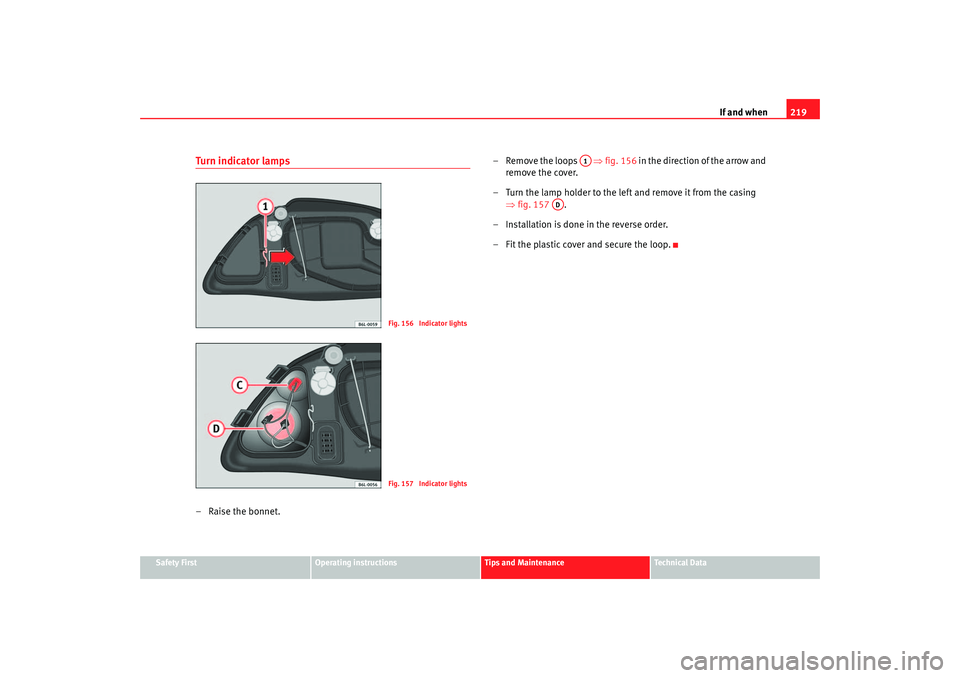
If and when219
Safety First
Operating instructions
Tips and Maintenance
Te c h n i c a l D a t a
Turn indicator lamps–Raise the bonnet. – Remove the loops
⇒fig. 156 in the direction of the arrow and
remove the cover.
– Turn the lamp holder to the left and remove it from the casing ⇒fig. 157 .
– Installation is done in the reverse order.
– Fit the plastic cover and secure the loop.
Fig. 156 Indicator lightsFig. 157 Indicator lights
A1
AD
ibiza_angles_0706_DEF Seite 219 Freitag, 1. September 2006 1:18 13
Page 222 of 268
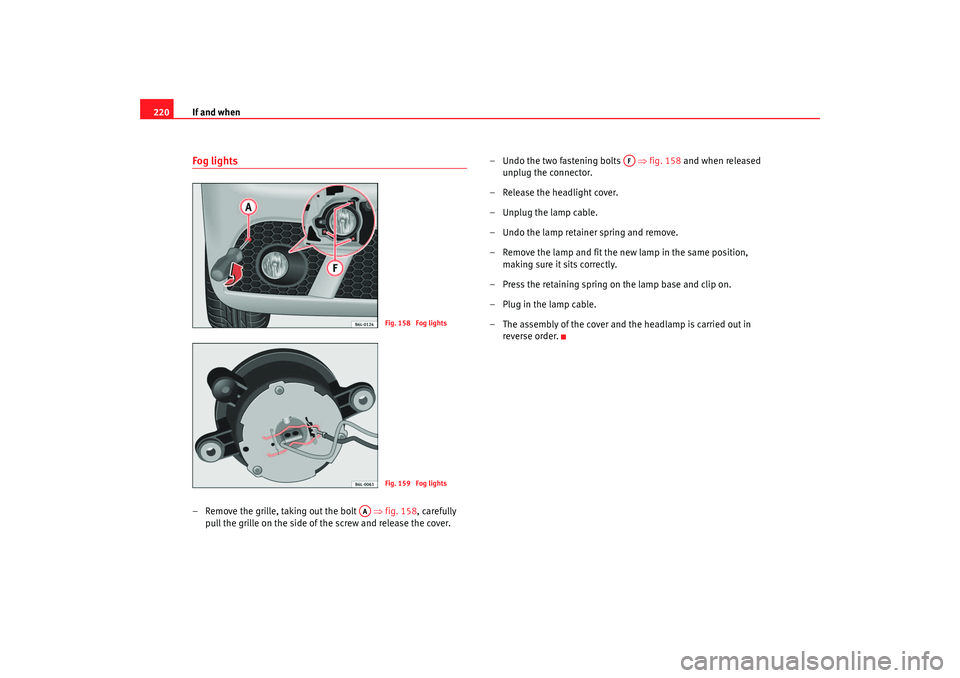
If and when
220Fog lights– Remove the grille, taking out the bolt ⇒fig. 158, carefully
pull the grille on the side of the screw and release the cover. – Undo the two fastening bolts
⇒fig. 158 and when released
unplug the connector.
– Release the headlight cover.
– Unplug the lamp cable.
– Undo the lamp retainer spring and remove.
– Remove the lamp and fit the new lamp in the same position, making sure it sits correctly.
– Press the retaining spring on the lamp base and clip on.
– Plug in the lamp cable.
– The assembly of the cover and the headlamp is carried out in reverse order.
Fig. 158 Fog lightsFig. 159 Fog lights
AA
AF
ibiza_angles_0706_DEF Seite 220 Freitag, 1. September 2006 1:18 13
Page 223 of 268
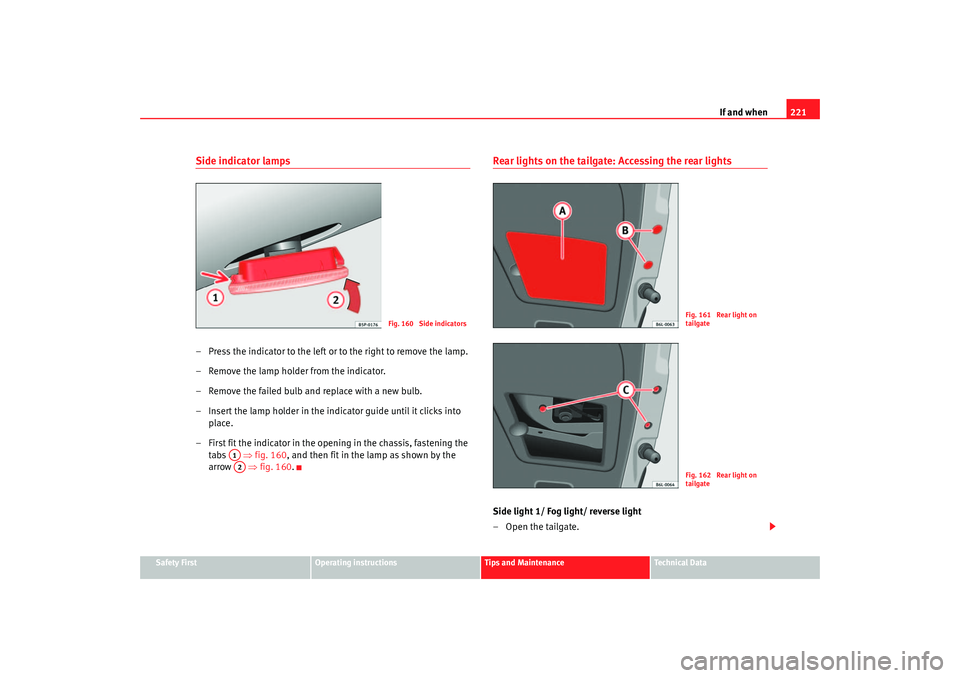
If and when221
Safety First
Operating instructions
Tips and Maintenance
Te c h n i c a l D a t a
Side indicator lamps– Press the indicator to the left or to the right to remove the lamp.
– Remove the lamp holder from the indicator.
– Remove the failed bulb and replace with a new bulb.
– Insert the lamp holder in the indicator guide until it clicks into
place.
– First fit the indicator in the opening in the chassis, fastening the tabs ⇒fig. 160 , and then fit in the lamp as shown by the
arrow ⇒fig. 160.
Rear lights on the tailgate: Accessing the rear lightsSide light 1/ Fog light/ reverse light
–Open the tailgate.
Fig. 160 Side indicators
A1A2
Fig. 161 Rear light on
tailgateFig. 162 Rear light on
tailgate
ibiza_angles_0706_DEF Seite 221 Freitag, 1. September 2006 1:18 13
Page 224 of 268
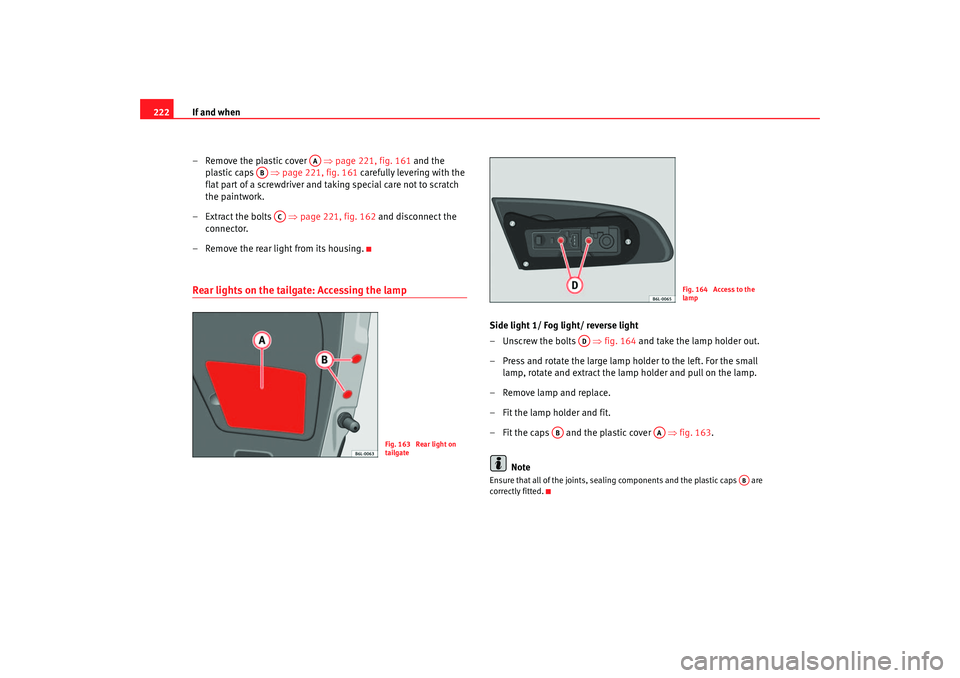
If and when
222
– Remove the plastic cover ⇒page 221, fig. 161 and the
plastic caps ⇒page 221, fig. 161 carefully levering with the
flat part of a screwdriver and taking special care not to scratch
the paintwork.
– Extract the bolts ⇒page 221, fig. 162 and disconnect the
connector.
– Remove the rear light from its housing.Rear lights on the tailgate: Accessing the lamp
Side light 1/ Fog light/ reverse light
– Unscrew the bolts ⇒fig. 164 and take the lamp holder out.
– Press and rotate the large lamp holder to the left. For the small lamp, rotate and extract the lamp holder and pull on the lamp.
– Remove lamp and replace.
– Fit the lamp holder and fit.
– Fit the caps and the plastic cover ⇒fig. 163.
NoteEnsure that all of the joints, sealing components and the plastic caps are
correctly fitted.
AA
AB
AC
Fig. 163 Rear light on
tailgate
Fig. 164 Access to the
lamp
AD
AB
AA
AB
ibiza_angles_0706_DEF Seite 222 Freitag, 1. September 2006 1:18 13
Page 225 of 268
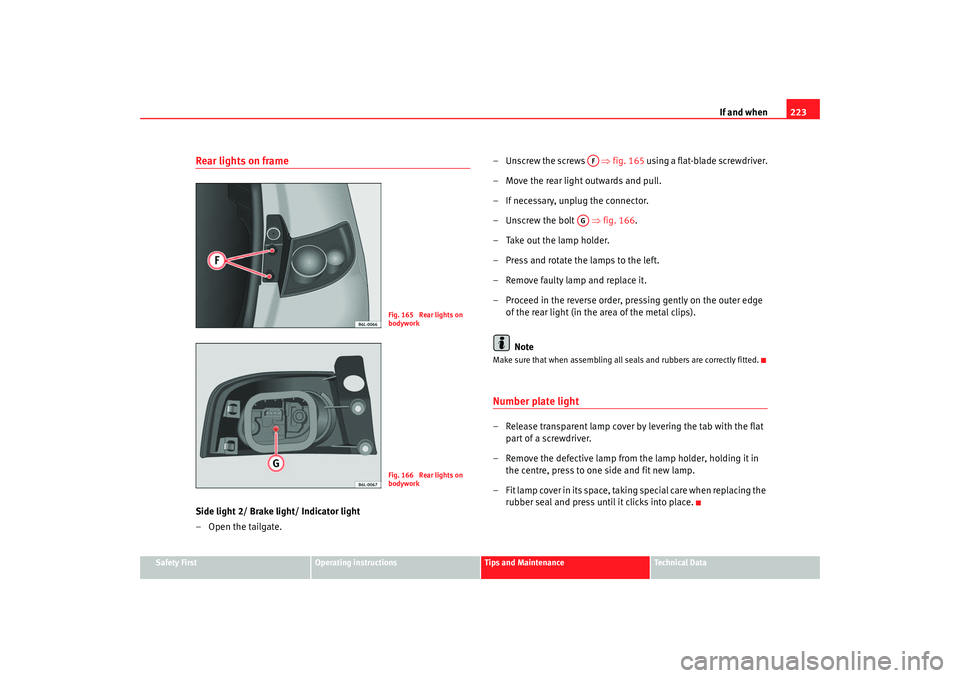
If and when223
Safety First
Operating instructions
Tips and Maintenance
Te c h n i c a l D a t a
Rear lights on frameSide light 2/ Brake light/ Indicator light
– Open the tailgate. – Unscrew the screws
⇒fig. 165 using a flat-blade screwdriver.
– Move the rear light outwards and pull.
– If necessary, unplug the connector.
– Unscrew the bolt ⇒fig. 166 .
– Take out the lamp holder.
– Press and rotate the lamps to the left.
– Remove faulty lamp and replace it.
– Proceed in the reverse order, pressing gently on the outer edge of the rear light (in the area of the metal clips).
Note
Make sure that when assembling all seals and rubbers are correctly fitted.Number plate light– Release transparent lamp cover by levering the tab with the flat part of a screwdriver.
– Remove the defective lamp from the lamp holder, holding it in the centre, press to one side and fit new lamp.
– Fit lamp cover in its space, taking special care when replacing the rubber seal and press until it clicks into place.
Fig. 165 Rear lights on
bodyworkFig. 166 Rear lights on
bodywork
AF
AG
ibiza_angles_0706_DEF Seite 223 Freitag, 1. September 2006 1:18 13
Page 226 of 268
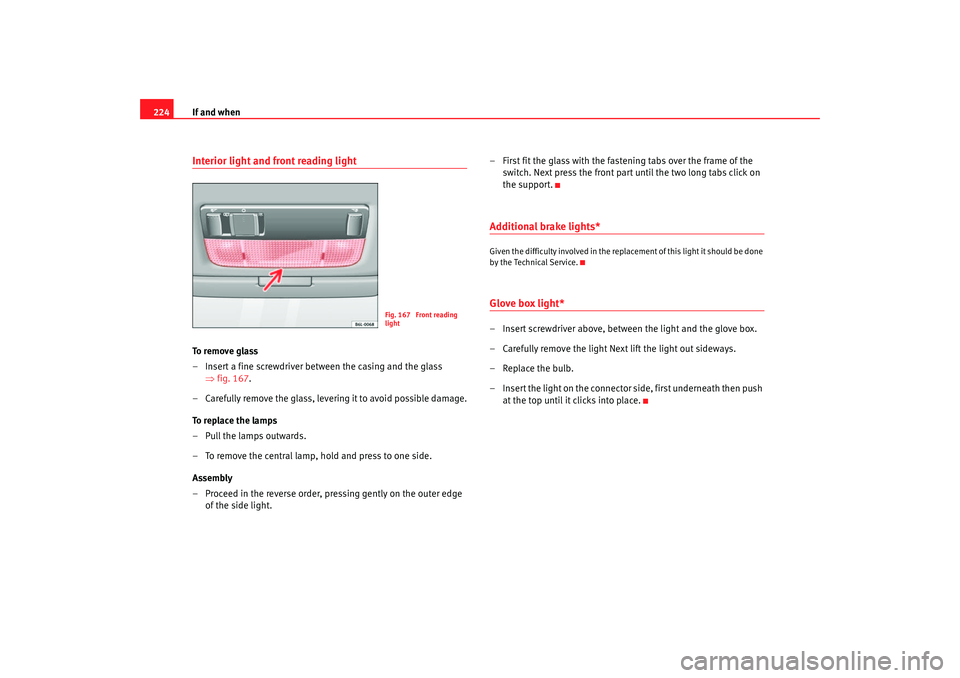
If and when
224Interior light and front reading light To r e m o v e g l a s s
– Insert a fine screwdriver between the casing and the glass
⇒fig. 167.
– Carefully remove the glass, levering it to avoid possible damage.
To replace the lamps
– Pull the lamps outwards.
– To remove the central lamp, hold and press to one side.
Assembly
– Proceed in the reverse order, pressing gently on the outer edge of the side light. – First fit the glass with the fastening tabs over the frame of the
switch. Next press the front part until the two long tabs click on
the support.
Additional brake lights*Given the difficulty involved in the replacement of this light it should be done
by the Technical Service.Glove box light*– Insert screwdriver above, between the light and the glove box.
– Carefully remove the light Next lift the light out sideways.
– Replace the bulb.
– Insert the light on the connector side, first underneath then push at the top until it clicks into place.
Fig. 167 Front reading
light
ibiza_angles_0706_DEF Seite 224 Freitag, 1. September 2006 1:18 13
Page 227 of 268
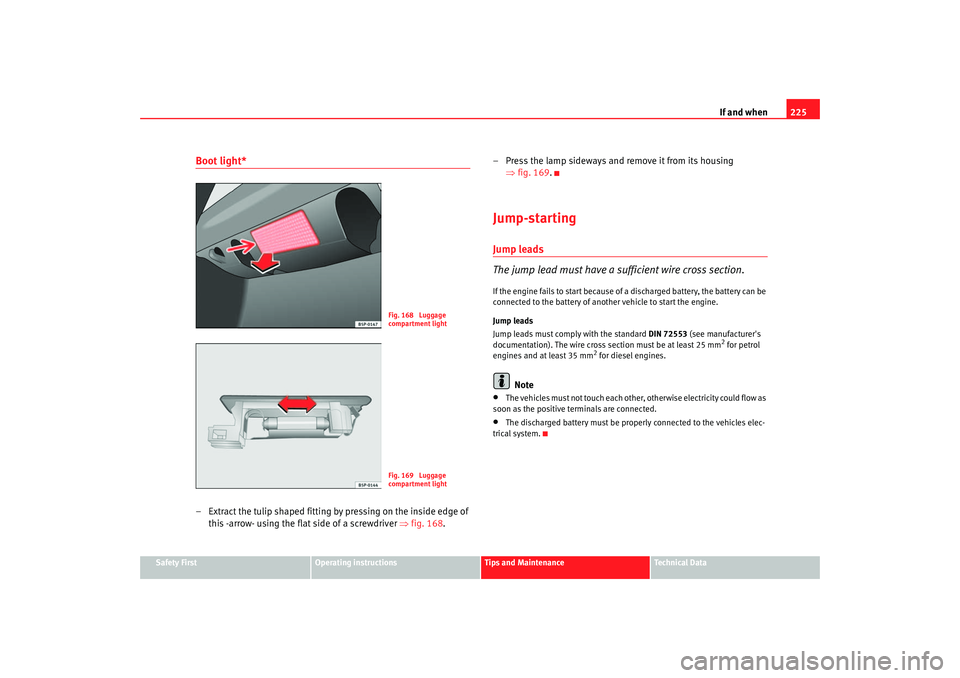
If and when225
Safety First
Operating instructions
Tips and Maintenance
Te c h n i c a l D a t a
Boot light*– Extract the tulip shaped fitting by pressing on the inside edge of
this -arrow- using the flat side of a screwdriver ⇒ fig. 168. – Press the lamp sideways and remove it from its housing
⇒fig. 169.
Jump-startingJump leads
The jump lead must have a sufficient wire cross section.If the engine fails to start because of a discharged battery, the battery can be
connected to the battery of another vehicle to start the engine.
Jump leads
Jump leads must comply with the standard DIN 72553 (see manufacturer's
documentation). The wire cross section must be at least 25 mm
2 for petrol
engines and at least 35 mm
2 for diesel engines.
Note
•
The vehicles must not touch each othe r, otherwise electricity could flow as
soon as the positive terminals are connected.
•
The discharged battery must be properly connected to the vehicles elec-
trical system.
Fig. 168 Luggage
compartment lightFig. 169 Luggage
compartment light
ibiza_angles_0706_DEF Seite 225 Freitag, 1. September 2006 1:18 13
Page 228 of 268
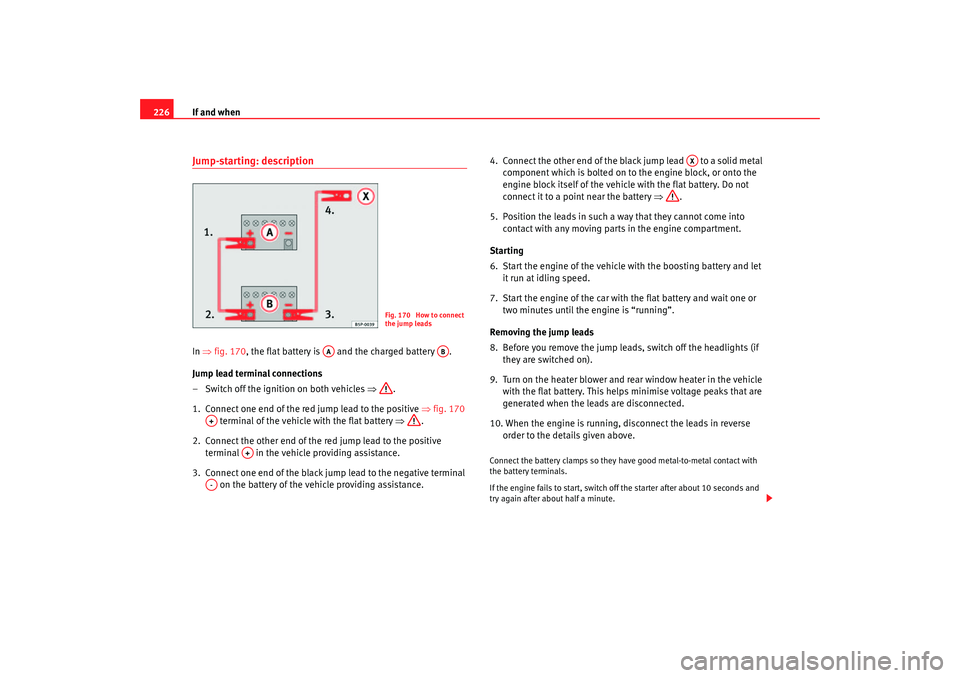
If and when
226Jump-starting: descriptionIn ⇒ fig. 170, the flat battery is and the charged battery .
Jump lead terminal connections
– Switch off the ignition on both vehicles ⇒.
1. Connect one end of the red jump lead to the positive ⇒fig. 170
terminal of the vehicle with the flat battery ⇒.
2. Connect the other end of the red jump lead to the positive terminal in the vehicle providing assistance.
3. Connect one end of the black jump lead to the negative terminal on the battery of the vehicle providing assistance. 4. Connect the other end of the black jump lead to a solid metal
component which is bolted on to the engine block, or onto the
engine block itself of the vehicle with the flat battery. Do not
connect it to a point near the battery ⇒.
5. Position the leads in such a way that they cannot come into contact with any moving parts in the engine compartment.
Starting
6. Start the engine of the vehicle with the boosting battery and let it run at idling speed.
7. Start the engine of the car with the flat battery and wait one or two minutes until the engine is “running”.
Removing the jump leads
8. Before you remove the jump leads, switch off the headlights (if they are switched on).
9. Turn on the heater blower and rear window heater in the vehicle with the flat battery. This helps minimise voltage peaks that are
generated when the leads are disconnected.
10. When the engine is running, disconnect the leads in reverse order to the deta ils given above.
Connect the battery clamps so they have good metal-to-metal contact with
the battery terminals.
If the engine fails to start, switch off the starter after about 10 seconds and
try again after about half a minute.
Fig. 170 How to connect
the jump leads
AA
AB
A+
A+
A-
AX
ibiza_angles_0706_DEF Seite 226 Freitag, 1. September 2006 1:18 13
Page 229 of 268
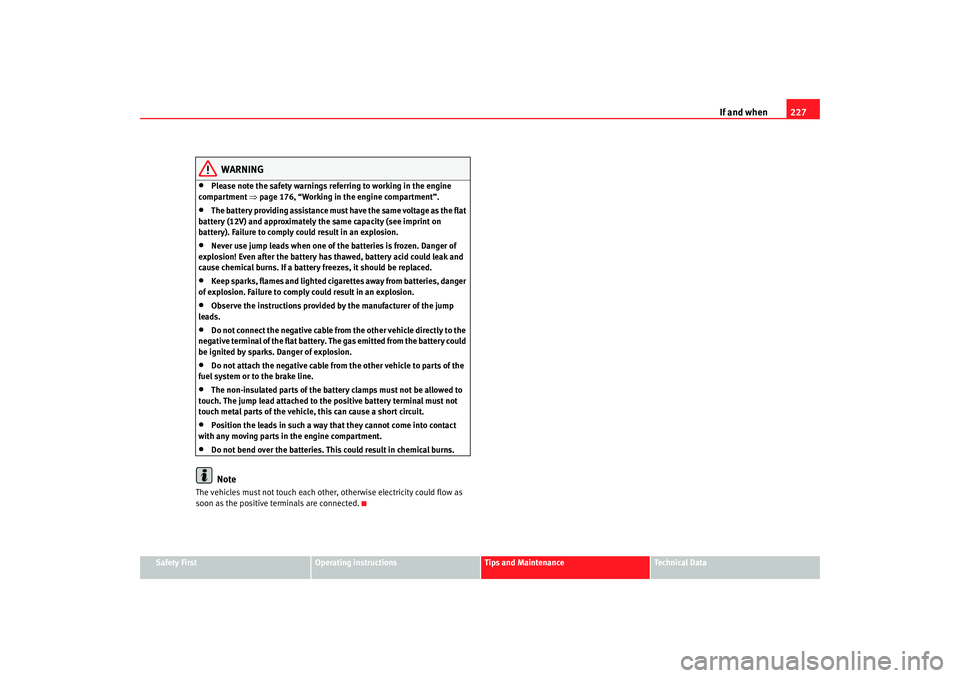
If and when227
Safety First
Operating instructions
Tips and Maintenance
Te c h n i c a l D a t a
WARNING
•
Please note the safety warnings referring to working in the engine
compartment ⇒page 176, “Working in the engine compartment”.
•
The battery providing assistance must have the same voltage as the flat
battery (12V) and approximately the same capacity (see imprint on
battery). Failure to comply could result in an explosion.
•
Never use jump leads when one of the batteries is frozen. Danger of
explosion! Even after the battery has thawed, battery acid could leak and
cause chemical burns. If a battery freezes, it should be replaced.
•
Keep sparks, flames and lighted cigarettes away from batteries, danger
of explosion. Failure to comply could result in an explosion.
•
Observe the instructions provided by the manufacturer of the jump
leads.
•
Do not connect the negative cable from the other vehicle directly to the
negative terminal of the flat battery. The gas emitted from the battery could
be ignited by sparks. Danger of explosion.
•
Do not attach the negative cable from the other vehicle to parts of the
fuel system or to the brake line.
•
The non-insulated parts of the battery clamps must not be allowed to
touch. The jump lead attached to the positive battery terminal must not
touch metal parts of the vehicle, this can cause a short circuit.
•
Position the leads in such a way that they cannot come into contact
with any moving parts in the engine compartment.
•
Do not bend over the batteries. This could result in chemical burns.Note
The vehicles must not touch each other, otherwise electricity could flow as
soon as the positive terminals are connected.
ibiza_angles_0706_DEF Seite 227 Freitag, 1. September 2006 1:18 13
Page 230 of 268
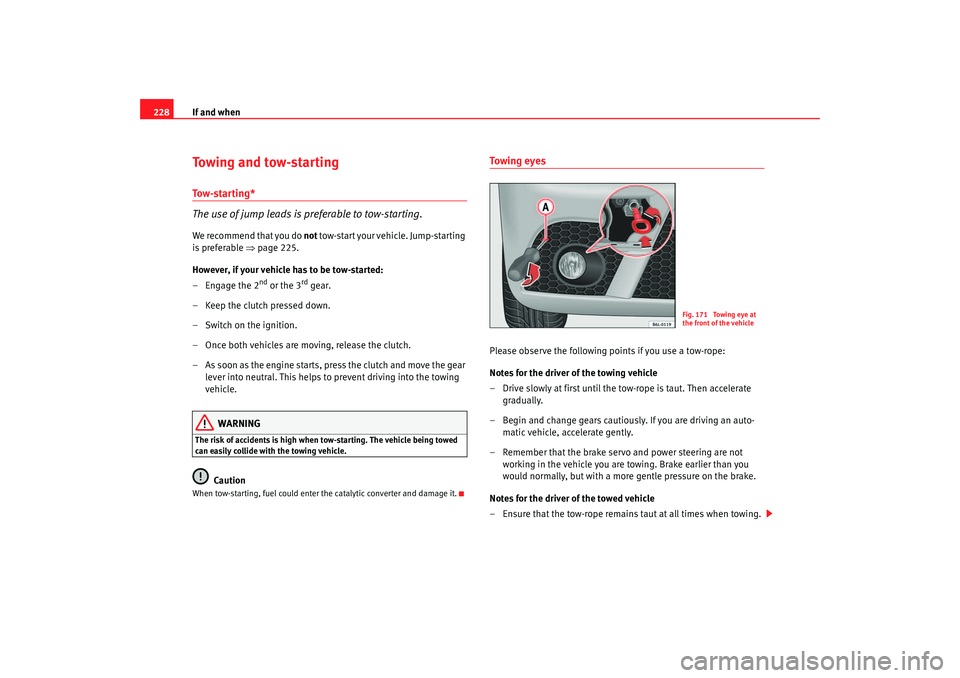
If and when
228To w i n g a n d t o w - s t a r t i n gTo w - s t a r t i n g *
The use of jump leads is preferable to tow-starting.We recommend that you do not t o w - s t a r t yo u r v e h i c l e . J u m p - s ta r t i n g
is preferable ⇒page 225.
However, if your vehicle has to be tow-started:
– Engage the 2
nd or the 3
rd gear.
– Keep the clutch pressed down.
– Switch on the ignition.
– Once both vehicles are moving, release the clutch.
– As soon as the engine starts, press the clutch and move the gear lever into neutral. This helps to prevent driving into the towing
vehicle.
WARNING
The risk of accidents is high when tow-starting. The vehicle being towed
can easily collide with the towing vehicle.
Caution
When tow-starting, fuel could enter the catalytic converter and damage it.
Towing eyesPlease observe the following points if you use a tow-rope:
Notes for the driver of the towing vehicle
– Drive slowly at first until the tow-rope is taut. Then accelerate gradually.
– Begin and change gears cautiously. If you are driving an auto- matic vehicle, accelerate gently.
– Remember that the brake servo and power steering are not working in the vehicle you are towing. Brake earlier than you
would normally, but with a more gentle pressure on the brake.
Notes for the driver of the towed vehicle
– Ensure that the tow-rope remains taut at all times when towing.
Fig. 171 Towing eye at
the front of the vehicle
ibiza_angles_0706_DEF Seite 228 Freitag, 1. September 2006 1:18 13